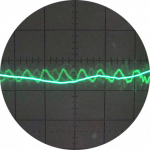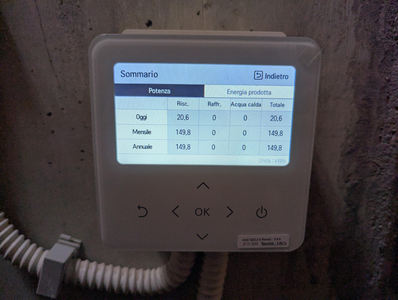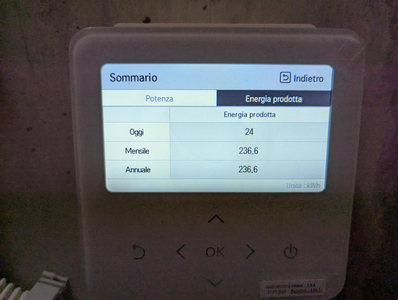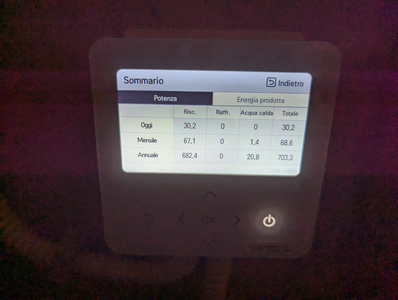ASHP heat output monitoring
Hi, I'm a new member from Italy, with a new LG therma V ASHP with an abysmal COP (about 1.6).
For now I'm basing my calculations from the information given by the heat pump panel, but I would like an independent way of measuring, ideally integrable with Home Assistant.
I already put in place a Shelly to measure the power consumption, but I need something to measure the heat output.
I need two temperature sensors and a flow meter, but the ready made kit I found, such as the OpenEnergyMonitor ones are a tad expensive.
I wonder if there are other kits around or some guides to DIY it with cheaper components.
I will probably also open a topic on my specific installation but right now I want to be able to collect evidence to better argue with the installer.
Thank you
10kW PV
14kW LG Therma V ASHP
Induction heater
@carlo - welcome to the forum.
I don't know about LG, but my Midea heat pump and many other brands collect and report raw heat output data ie flow rate, leaving water temp (LWT) and returning water temp (RWT) which gives delta t and with the circulating fluid specific heat can be used to calculate the heat output. You may already be doing that, but if not, it might be worth a try.
I appreciate you want an independent of data, but the kit needed is not, as you say cheap, and it is necessarily invasive. As it happens I had an analogue flow meter added by my installer at installation time on the radiator circuit, and I use that to crudely verify the the Midea flow rate figures, which are pretty similar. I also rather crudely verify the delta t with an infra red thermometer on the flow and return pipework, and again the Midea figures aren't that far out. So far, I have taken the view the Midea data is 'good enough'.
A couple of other points. If you are calculating a COP, then you must also be collecting energy in. Are you confident that side of things is accurate? The other is that these things are much easier to do when it is cold outside and the heating is on. I can't help wondering whether your low COP is somehow related to operating a heat pump in warm weather - I presume it is warm in Italy! Or perhaps you up at a very high altitude where it is cold!
More details about your system might help us give better answers.
And a final thought - in a way, LG generated data is the ideal data with which to approach your installer. They have to believe it (they installed it!) - or else they have to go through some compromising routine of saying yes we did install it, but we don't believe it.
Midea 14kW (for now...) ASHP heating both building and DHW
I installed the heat pump in December '24, so the data is from last winter. Right now, and since march, it is only making DHW.
I want to be ready to better measure this coming winter.
These two pictures from the Heat Pump panel show the "potenza", power, which is the electrical energy consumed, and "energia generata", energy generated, which is the heat output.
The pictures where taken the sixth of January, and by doing a division report a COP of about 1.6.
Dividing by the five preceding days it gives me about 2kw continuous, which seems to me a little low and way less than the 14kw machine that was installed.
Water output was set at 40° and later in the winter even lowered to 37° without appreciable differences.
The system is also not well installed, the workmanship is nice, but the design leaves a lot to be desired.
For example I have a 100l buffer tank on the return of the heating system, but they also put it on the return of the DHW tank.
So now when I heat the DHW I also heat 100 more liters of the buffer tank.
10kW PV
14kW LG Therma V ASHP
Induction heater
@carlo - Do you have any more recent readings, even the current ones. Just a few days in mid winter immediately after installation isn't much to go on.
You will already know this I suspect, but worth emphasing that buffer isn't doing you any favours - if it is a buffer rather than a volumiser. The way you describe it suggests it may be the latter?
Midea 14kW (for now...) ASHP heating both building and DHW
@cathoderay The buffer got lost in translation, it is a volumizer. In Italian it is referred to as "puffer" for some reason or "volano termico", thermal flywheel.
The output of the heat pump is connected directly to the heating system.
These are some more measurements taken the second of February:
Electrical energy consumed. The lines are day, month, year. The columns are heating, cooling, DHW, total:
Thermal energy produced:
For that week I have the power profile of the heat pump, at this point the outgoing water temperature was set to 37°:
The 6kw peaks are the DHW cycles. After the cycle it goes to zero because the volumizer is installed on the return of the DHW.
So when it makes DHW the volumizer also gets to 50°, which is higher than the 37° requested of the system.
The outside temperature:
And the internal temperature:
I will add a bit more information, but at this point maybe it would be best to open a dedicated topic:
The house is about 190m2, on two levels, one of which is the basement. I have another apartment on top of me.
Windows are double panes with aluminium frames.
Walls are about 30-40cm thick, made of two hollow brick walls with a cavity between them, with a flimsy sheet of paper backed mineral wool in that space.
The basement floor has no insulation. The basement walls are made with one layer of hollow bricks and then there is a 1m cavity separating them from the reinforced concrete retaining walls.
The heating system is made of aluminium radiators connected with 12mm pipes. I don't remember the diameter of the big feeding pipes but I think it was on the order of 30mm.
These are the new version of my radiators, not the same but very close:
Radiatori per il riscaldamento domestico - Sira Industrie
I have in total 98 elements of the 600mm sized ones.
I hope I have included enough information.
10kW PV
14kW LG Therma V ASHP
Induction heater
Posted by: @carloThe buffer got lost in translation
But Italian is still a beautiful language!
I agree that over the longer (but still not very long) period the COP appears to be less than 2, which is not good.
If I were in your position, I would start by looking into (a) how LG derive the energy in and out figures including what they actually represent because at least one manufacturer's (Grant?) energy out data is not the total energy out but the extra energy produced over and above what is put in, thus COP = (energy in + extra energy out) / energy in and (b) is there any data I already have, or can easily collect, that can verify the LG reported figures. Does the heat pump have its own dedicated supply, and if so, does that have any metering on it?
Midea 14kW (for now...) ASHP heating both building and DHW
Posted by: @cathoderayat least one manufacturer's (Grant?) energy out data is not the total energy out but the extra energy produced over and above what is put in, thus COP = (energy in + extra energy out) / energy in and (b)
Same with Vaillant btw
4kW peak of solar PV since 2011; EV and a 1930s house which has been partially renovated to improve its efficiency. 7kW Vaillant heat pump.
Posted by: @jamespaSame with Vaillant btw
Thanks. It may be just Vaillant, not Grant, I just had a vague recollection that not all manufacturers present their data in the same way, but couldn't track down which one I had come across. The question for @carlo is what do LG do?
Midea 14kW (for now...) ASHP heating both building and DHW
@cathoderay I had the same thought about the "energy produced" pane, but the LG documentation is extremely lacking on explanations:
The bottom part, the ones related to the energy statistics, roughly says:
"information include instantaneous power and the use of energy/calories up to the annual tendency"
Which means nothing. If the phrase sounds broken is because it is also broken in Italian.
Besides, if it were actually the extra thermal energy produced, the COP would go from 1.6, unacceptable, to 2.6, not particularly good.
With 40° of water temperature and 2-7° outside one LG advertises between 4.05 and 4.5.
To get to 2.6 the outside temperature needs to be -15.
1.6 isn't anywhere on the table.
I know the advertised ones are not necessarily real, but still...
One of the LG technicians that came to see the system said that I was making the right calculations, but I really don't trust them to know. (for reference: other LG technicians, the ones who came to do the first start of the machine said that I should set it at 55° because I have radiators with the thermostat to turn it off when the house reaches temperature. So sometimes it is off and I save money)
For the electrical consumption I have a shelly installed that confirms, with single digit difference, the numbers on the panel.
For the thermal output I would like to install something on the heat pump, hence this very topic.
I did try to make some power output calculations based on my radiators, by knowing the in and out temperature and the room temperature. Considering 20° inside, 37° output and 34° input my radiators give about 2.8KW, but I don't know if it is accurate enough to reach any conclusion.
10kW PV
14kW LG Therma V ASHP
Induction heater
Posted by: @carloBesides, if it were actually the extra thermal energy produced, the COP would go from 1.6, unacceptable, to 2.6, not particularly good.
As you say its poor either way. I have tried to find out how they calculate it from the manual (which is pretty poor) but cannot. I will keep trying!
If you would like some suggestions can you start a new thread and post some information about your system:
- House calculated heat loss and design OAT
- House area and construction
- Model of heat pump
- Buffer/no buffer, any other system separation (low loss header/plate heat exchanger)
- volumiser/no volumiser, where plumbed (flow/return)
- type of emitters, any detail about them you can give us
- weather compensation parameters/flow temperatures
- picture of DHW tank and surrounding plumbing
- If you have one, a system diagram
- how is it operated - any thermostats or TRVs and if so how are they set (eg 2+C above target temp, to max, or at target temp
If you can post any plots of power consumption (for the heat pump if possible but even the total for the house will do) that would help us understand whats going on also. If you have a way to get flow temperature vs time that also
I know you have posted some of this already but its helps to keep it all together and anyway if you are starting a new thread it saves switching backwards and forwards.
If you cant do all of this do what you can.
Once we have some more info about the system Im sure you will get plenty of suggestions of things to explore. From what you have already said I can see a few things, but not that would account for a COP of 1.6 or 2.6.
4kW peak of solar PV since 2011; EV and a 1930s house which has been partially renovated to improve its efficiency. 7kW Vaillant heat pump.
I will gather thoughts/data and open a new topic. Meanwhile I will continue to hunt for some way to measure the heat output of the heat pump independently of its panel. If nothing else to be able to log it decently. Thanks for the help for now.
10kW PV
14kW LG Therma V ASHP
Induction heater
Posted by: @carloMeanwhile I will continue to hunt for some way to measure the heat output of the heat pump independently of its panel.
As you know, you need the flow rate to do that, and I think the only way you can get that is to fit a third party meter, which is both invasive and not exactly cheap. But it, plus temp sensors, will give you what you want.
Earlier point about the LG documentation in Italian noted. Can you find an English technical/service manual for the heat pump you have?
Midea 14kW (for now...) ASHP heating both building and DHW
- 26 Forums
- 2,372 Topics
- 53.8 K Posts
- 126 Online
- 6,053 Members
Join Us!
Worth Watching
Latest Posts
-
RE: Solar Power Output – Let’s Compare Generation Figures
2025 energy total: 7.4mW produced, 5.4mWh exported, 3.0...
By jamespetts , 5 hours ago
-

RE: Testing new controls/monitoring for Midea Clone ASHP
If I had to make a guess, I’d say that there are one or...
By Majordennisbloodnok , 5 hours ago
-
RE: Connecting Growatt SPH5000 over wired ethernet rather than wireless
Thanks folks. I had tried googling an ethernet lab adap...
By z8lccda , 6 hours ago
-
RE: Data Accuracy Problem: Daikin 8kW Heat Pump's Onecta App vs MMI Power Consumption
@toodles Good evening. Thankyou for the response I...
By Nursethescreens , 6 hours ago
-
RE: Changing from 4-port buffer to volumizer
@toodles I'm not concerned that the behaviour is not no...
By Andy1618 , 6 hours ago
-

-

RE: Forum updates, announcements & issues
As we head into 2026, I just wanted to take a moment to...
By Mars , 10 hours ago
-

RE: Setback savings - fact or fiction?
I agree, and I think there are two things in play here....
By cathodeRay , 11 hours ago
-
RE: Water Hammer After Heat Pump Install
That's really helpful. Yor last sentence confirms it'...
By JamesPa , 17 hours ago
-
RE: Help needed with Grant Aerona 3 issues
First time posting so bear with me. Some bits that have...
By Adamp , 1 day ago
-
RE: Mitsu PUHZ-SW120YHA + EHSC-VM20Uk - Performance
All understood. Obviously its a bit house de...
By JamesPa , 1 day ago
-
RE: Who's your electricity provider and what's your tariff?
@majordennisbloodnok This may be a better thread to ...
By Batpred , 2 days ago
-

RE: Best Heat Pump Brand in the UK
Last Call to Vote & Win! Haven't voted for your Hea...
By Mars , 2 days ago
-

RE: Solis S6-EH1P8K-L-PLUS – Why I Chose It and What I’ve Learned So Far
Interesting question. To be frank, since I have no inte...
By Majordennisbloodnok , 3 days ago
-
RE: New Fogstar 15.5kWh upright solution
The video shows the JK balancer, but the connection of ...
By Batpred , 3 days ago
-
RE: Ecodan unable to hit legionella target temp - what's the consensus?
@9jwr9 Hi, yes this is the issue with every (stand alon...
By ASHP-BOBBA , 3 days ago
-
RE: Help me keep the faith with my air source heat pump installation
@adamk FWIW I managed unintentionally to 'coax' mine in...
By JamesPa , 3 days ago
-
RE: Octopus Cosy Heat Pump Owners & Discussion Thread
You are in essence right. Adia only works with selecte...
By JamesPa , 3 days ago
-

No, you haven’t missed out, @batpred. This thread’ll st...
By Majordennisbloodnok , 3 days ago












